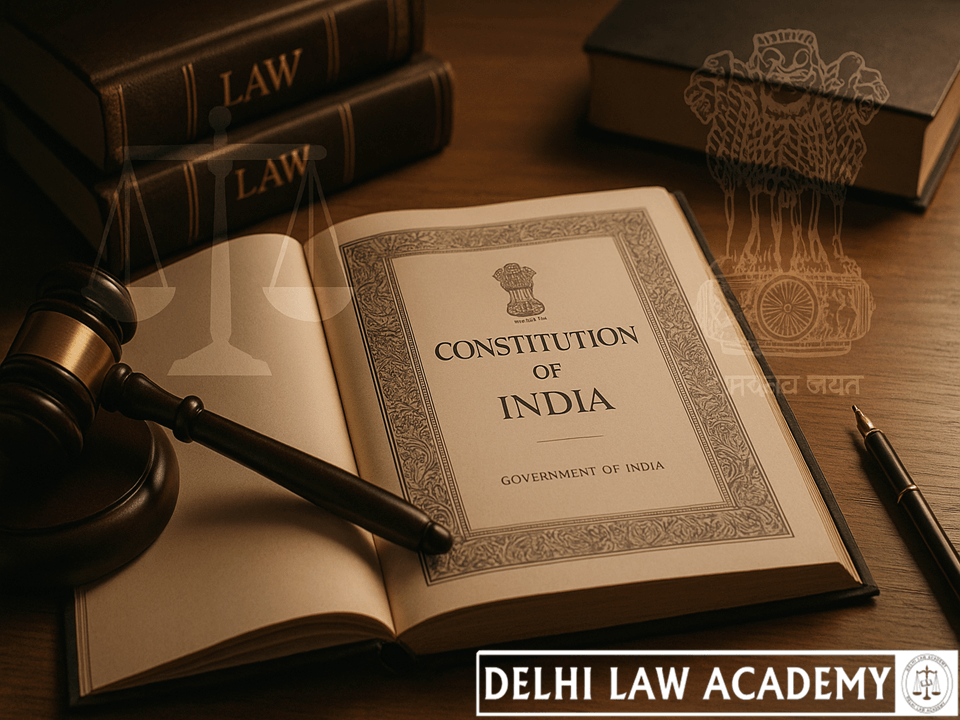
⚖️ Union Judiciary – Articles 124 to 129 of the Constitution of India
Delhi Law Academy Jaipur | Notes for RJS, DJS & PCS(J) Judiciary Aspirants
📘 Constitutional Provisions
Article 124(4) – Removal of Supreme Court Judges
Grounds :
- Proved misbehaviour or
- Incapacity
Procedure :
- A Supreme Court judge can be removed from office by an order of President.
- Such an order can be passed only when each House passes a resolution by a majority of total membership of that House and a majority of not less than two-thirds of the members present and voting.
- Such resolutions must be presented to President in the same session.
Article 124(5)
- Procedure for presentation of address and investigation and proof of misbehaviour or incapacity shall be regulated by Parliament by law.
📜 Explanatory Notes from DLA – The Judges Inquiry Act 1968
- Notice of motion: The notice must be signed by not less than 100 members of Lok Sabha or 50 members of Rajya Sabha.
- Role of Speaker/Chairman: They may either admit or refuse to admit the motion.
- If admitted, a committee of three members (one SC Judge, one HC CJ, and one jurist) is constituted to investigate.
- If the committee finds the Judge not guilty or incapable – no further action is taken.
- If guilty – motion is taken up by Parliament and if adopted by both Houses with required majority, an address for removal is presented to the President.
🧾 The first-ever impeachment motion:
Against Justice V. Ramaswami (1991) – signed by 108 MPs. Inquiry found him guilty of “wilful and gross misuse of office”, but the Lok Sabha vote fell short of the required two-thirds majority.
Article 124(6)
- A judge of SC shall make an oath before the President before entering office.
Article 124(7)
- An ex-judge of SC shall not plead or act in any court or before any authority in India.
Article 125 – Salaries
- Salaries, allowances and privileges of SC judges shall be determined by Parliament by law from time to time.
Article 126 – Acting Chief Justice
- When the office of Chief Justice is vacant or he is unable to perform his duties, such duties shall be performed by an SC judge appointed by the President.
Article 127 – Ad-hoc Judges
- The CJI may, with the President’s consent and after consultation with an HC CJ, request a High Court Judge qualified to be SC Judge to act as ad-hoc judge when there are not enough SC judges to hold session.
Article 128 – Retired Judges
- The CJI, with the President’s consent, may request a former SC or HC Judge to sit and act as a Judge of the Supreme Court. He has the same powers and privileges while so acting but is not deemed a regular Judge.
Article 129 – Court of Record
- The Supreme Court is a Court of Record and has the power to punish for contempt of itself.
📖 Comments from DLA – What is a Court of Record?
- A Court of Record is a court whose acts and proceedings are enrolled for perpetual memory and testimony. Its records are of such high authority that their truth cannot be questioned.
The Contempt of Courts Act 1971
- Two categories of contempt: Civil Contempt and Criminal Contempt.
⚖️ Civil Contempt
- Wilful disobedience to any judgment, decree, direction, order or writ, or wilful breach of an undertaking given to a court.
🚫 Criminal Contempt
- Publication or act that scandalises the court, prejudices a judicial proceeding or obstructs justice in any manner.
🧾 Punishment for Contempt of Court
- Simple imprisonment up to six months or fine up to ₹2,000 or both. An apology may lead to discharge if made bona fide.
📚 For more Constitution and Judiciary Notes, visit
www.delhilawacademy.com
📘 Stay Ahead with Delhi Law Academy!
Get access to free monthly current affairs, read our insightful blogs,
and explore free study resources prepared by experts at DLA Jaipur. 🚀
❓ Frequently Asked Questions on Union Judiciary Articles 124–129
Criminal Contempt involves acts that scandalise or lower the authority of the court, interfere with judicial proceedings, or obstruct the administration of justice. Both aim to preserve the dignity and functioning of the judiciary.
Contact us
📍 Delhi Law Academy – Jaipur Branch
6C, Tower 2, Coaching Hub, Pratap Nagar, Jaipur – 302033
📞 Phone:
+91 9911916552
+91 8447285606
✉️ Email:
contactus@delhilawacademy.com

